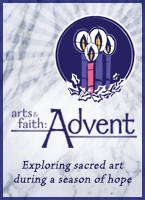Arts & Faith: Week 4 of Advent, Cycle C
Henry Ossawa Tanner, “The Visitation,” 1909–1910

Henry Ossawa Tanner’s realist depiction of the Visitation invites us around Elizabeth’s table at her house, at the moment when Mary arrives and greets her. The setting is spare, except for the table, which is covered in a white cloth and has bread, wine, and an ample bowl of fruit awaiting consumption.
Mary is just entering the house. Her face is kind and joyful, her bodily presence already humming the Magnificat before she utters the words that will come to sing her praise to the Lord. She is a familiar Mary, a relative to us all, and her warm presence recalls the homecomings and joyful arrivals of loved ones that we experience, especially around the holidays.
Elizabeth’s expression welcoming Mary is complex. In light of Tanner’s realist style, we would expect her rising from the table, moving toward Mary in anticipation of a warm embrace—and that is sure to come. But Tanner catches Elizabeth here in a moment of awe instead. If Mary’s body sings the Magnificat, Elizabeth embodies her words of awe and wonder: “How does this happen that the mother of my Lord should come to me?” Her upheld hands are in a position of prayer honoring the presence of God in their midst, in her home, around her table. Elizabeth’s expression is one of serene reverence, a total response to the divine presence she senses in the core of her being, confirmed by the stirring of the child in her womb. “Blessed are you, Mary”—this Elizabeth knows, utters, and prays.
The meeting between Mary and Elizabeth teaches us about the holy. Tanner shows us that we encounter the holy in the everyday moments of our lives—an arrival, a homecoming, a table set for a meal. But Elizabeth’s expression reminds us that while we find holiness in this world, it is not of this world, that finding holiness is a glimpse of God’s magnificent otherness that beckons us to draw close, but also fills us with wonder and awe. May we find and welcome holiness in these last days of Advent as we await the light of Christ.

Commentary is by Daniella Zsupan-Jerome, director of ministerial formation at Saint John's University School of Theology and Seminary.
Related Ignatian reflection on this week’s art
Week 4 of Advent, Cycle C

Recognizing God’s Presence (Ages 9–12)
Have small groups work together on a word search or hidden-picture puzzle. Help one another until everyone has found each of the words or pictures in the puzzle. Talk about this experience, noticing how some people found words or pictures more easily than others and how easy it was to see the word or picture once someone else pointed it out. Observe that sometimes we need the help of others to recognize God’s presence and action in our lives. Read together Luke 1:39–45. Ask: What did Elizabeth recognize about Mary? (that she was to be the mother of Jesus, the Lord) How did Elizabeth know this? (Her baby, John the Baptist, leapt with joy at Mary’s greeting.) Pray that as we share our faith together, we may help one another recognize God’s presence and action in our lives. Close by praying together the Hail Mary.
Praying the Magnificat (Ages <9–12
The reflection on Tanner’s The Visitation mentions the Magnificat. Help children learn about this Marian prayer by leading the group in praying together in a special way. Before class, prepare numbered sentence strips for each of the sentences of the Magnificat, with as many duplicates as needed for each child to have a sentence. Gather the children together and read the Magnificat aloud with expression, stopping occasionally to ask if this is something they would want to say to God too. Tell the children that they can pray Mary’s beautiful song of praise to thank God for all he has done for them. Ask the children to come forward, take a sentence strip from you, and form a large circle. Practice by asking all those with the number-one sentence to read it with you. Do the same for the rest of the sentences. Tell children you will now do a choral reading of the prayer. Tell them to listen for their number. When they hear you say their number, they should take two steps toward the center of the circle and read their sentence with the meaningful expression Mary would have used. They should then step back to the circle. Invite those who would like to do so to add something special that they would like to praise God for by saying: I praise God for _________. Thank you, God. Continue to call numbers until the prayer is finished. Conclude by reminding the children to praise God often for his gifts and to pray Mary’s beautiful prayer.

